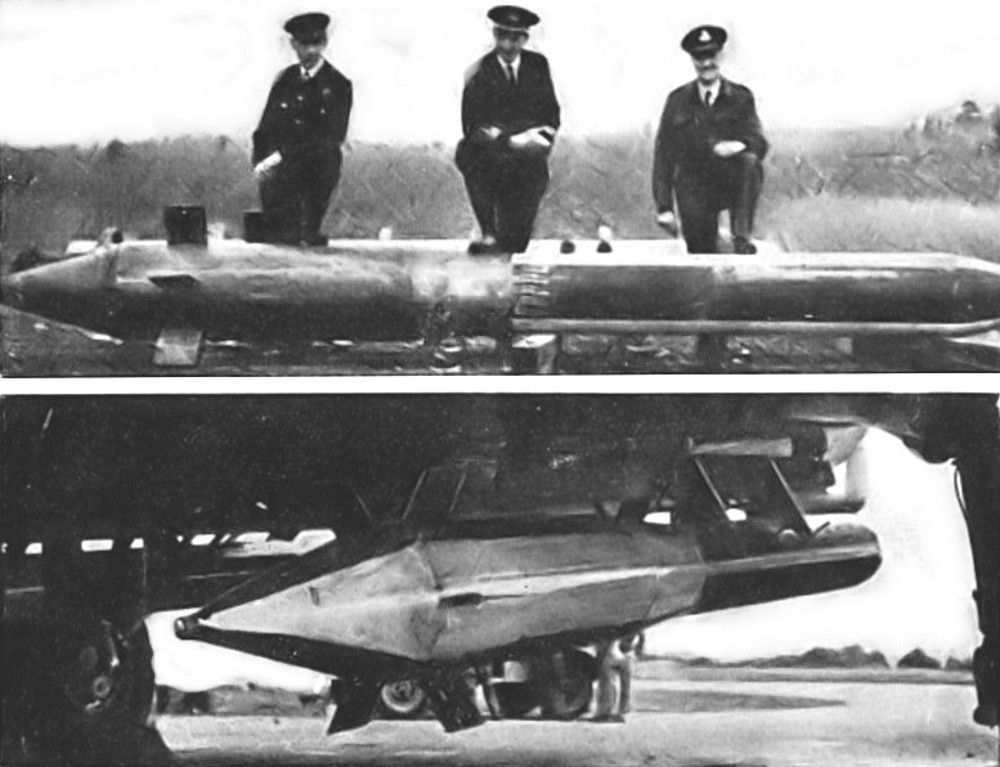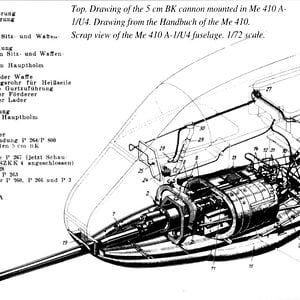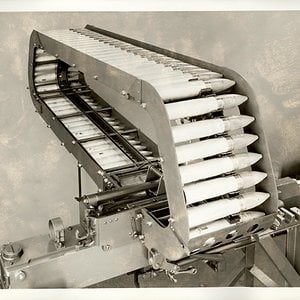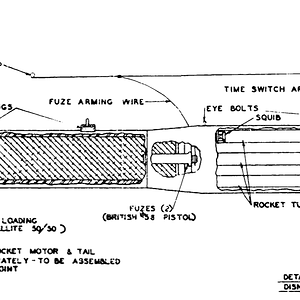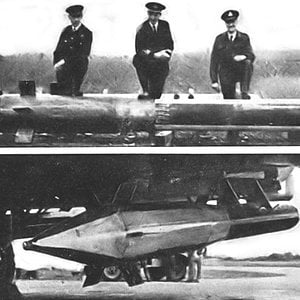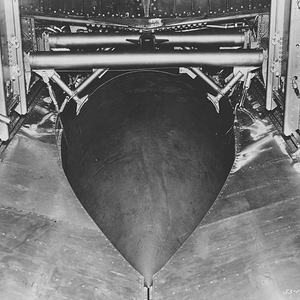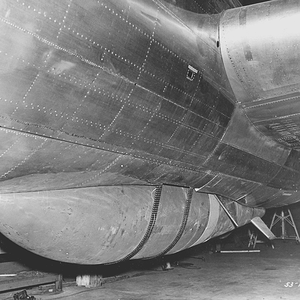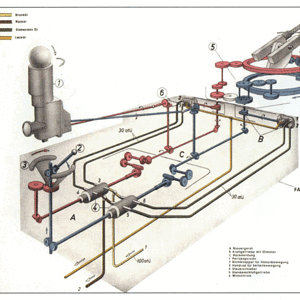Navigation
Install the app
How to install the app on iOS
Follow along with the video below to see how to install our site as a web app on your home screen.
Note: This feature may not be available in some browsers.
More options
You are using an out of date browser. It may not display this or other websites correctly.
You should upgrade or use an alternative browser.
You should upgrade or use an alternative browser.
Development and testing
A rocket–bomb destroys a U-boat pen in the Disney animated film Victory Through Air Power (1943)
According to an anecdote, the idea arose after a group of Royal Navy officers saw a similar, but fictional, bomb depicted in the 1943 Walt Disney animated propaganda film Victory Through Air Power,[Note 10] and the name Disney was consequently given to the weapon.[16] The Royal Navy developed the bomb[17] even though the Fleet Air Arm operated no aircraft capable of carrying it.[Note 11] The navy's interest in a concrete penetrating weapon can be explained by the German navy's extensive use of fortified submarine pens to protect their U-boats and E-boats from air attack while docked.
The Disney bomb was devised by a British naval officer, Captain Edward Terrell[18] of the Royal Naval Volunteer Reserve, who served in the Directorate of Miscellaneous Weapons Development.[19] Before the war, he had been a lawyer and the Recorder of Newbury.[20] However, he was also an enthusiastic inventor and had filed several patents pre-war, including ones for a vegetable peeling knife[21] and a bottle for fountain pen ink.[22]
The Disney bomb on the cover of Terrell's book Admiralty Brief: The Story of Inventions that Contributed to Victory in The Battle of the Atlantic (1958)
The bomb's development began in September 1943. Although there was support for the idea at the highest levels within the Admiralty, production of the weapon would have to come under the Ministry of Aircraft Production (MAP). The Road Research Laboratory[Note 12] provided theoretical formula for penetration from US data on the performance of 15-inch (381 mm) shells against reinforced concrete and the Chief Engineer of Armament Development at Fort Halstead prepared a preliminary design to present to the MAP. In the face of opposition, the First Sea Lord prepared a memorandum for the Anti-U-Boat Committee of which Churchill was the Chairman. Terrell visited Churchill's scientific adviser Lord Cherwell to convince him that it was feasible technically. Due to the Prime Minister's absence through illness, it was not until January 1944 that Churchill expressed a desire that the bomb should be considered by the committee. Due to the number of departments involved there were meetings involving large numbers of technicians and scientists to confirm the technical feasibility.[23]
Through the Air Technical Section of the USAAC, Terrell received support and was able to show the Admiralty a mockup under the wing of a Boeing B-17 Flying Fortress. The Air Ministry was still opposed to its development on several technical grounds and it took a meeting of the War Cabinet in May (which Terrell attended) to decide in its favour giving it "P plus" priority. A side effect of the meeting was it focused attention on the issue of the U-boat shelters and the RAF were directed to make attacks on them — dropping 26 Tallboys in August that year.[24]
American ground crew loading a Disney bomb onto a B-17 bomber[1]
Despite being a British weapon, Disneys were only used by the United States Army Air Force, with the bombs becoming a joint project between the American Eighth Air Force and the British Royal Navy; they were never used by RAF Bomber Command.[Note 13][Note 14] The 92nd Bombardment Group was initially tasked with their use. The bombs would also be dropped by the 305th Bombardment Group and 306th Bombardment Group. The 94th Bombardment Group prepared to use the bombs, but flew no operations with them before the war in Europe ended.[25] The B-17 Flying Fortresses operated by these units carried the bombs in pairs; one was slung under each wing as they were too long to be carried in the B-17's bomb bay. The Disneys were carried from the same external mounting that was used for the Aeronca GB-1 glide bomb.[26] Cameras were also fitted to the aircraft so the bombs' trajectory and effect could be recorded.[27]
Testing of the Disney bombs began in early 1945. Bombs were initially dropped on a bombing range near Southampton[clarification needed] to photographically record their trajectory and calibrate bombsights. This was necessary as the flight-path of a rocket-accelerated bomb differed considerably from that of a free–falling bomb.[11] Test drops were then conducted on the Watten bunker, German codename Kraftwerk Nord West (now known as the Blockhaus d'Éperlecques), a large German concrete bunker near Watten in northern France. This was ideal for the purpose as the area had been captured by Allied forces in September 1944, so damage to the structure could be inspected after bomb tests.[11] Four bombs, carried by two B-17s, were used and two hits scored on the target. The resultant damage was considered satisfactory by Royal Navy observers on the ground
A rocket–bomb destroys a U-boat pen in the Disney animated film Victory Through Air Power (1943)
According to an anecdote, the idea arose after a group of Royal Navy officers saw a similar, but fictional, bomb depicted in the 1943 Walt Disney animated propaganda film Victory Through Air Power,[Note 10] and the name Disney was consequently given to the weapon.[16] The Royal Navy developed the bomb[17] even though the Fleet Air Arm operated no aircraft capable of carrying it.[Note 11] The navy's interest in a concrete penetrating weapon can be explained by the German navy's extensive use of fortified submarine pens to protect their U-boats and E-boats from air attack while docked.
The Disney bomb was devised by a British naval officer, Captain Edward Terrell[18] of the Royal Naval Volunteer Reserve, who served in the Directorate of Miscellaneous Weapons Development.[19] Before the war, he had been a lawyer and the Recorder of Newbury.[20] However, he was also an enthusiastic inventor and had filed several patents pre-war, including ones for a vegetable peeling knife[21] and a bottle for fountain pen ink.[22]
The Disney bomb on the cover of Terrell's book Admiralty Brief: The Story of Inventions that Contributed to Victory in The Battle of the Atlantic (1958)
The bomb's development began in September 1943. Although there was support for the idea at the highest levels within the Admiralty, production of the weapon would have to come under the Ministry of Aircraft Production (MAP). The Road Research Laboratory[Note 12] provided theoretical formula for penetration from US data on the performance of 15-inch (381 mm) shells against reinforced concrete and the Chief Engineer of Armament Development at Fort Halstead prepared a preliminary design to present to the MAP. In the face of opposition, the First Sea Lord prepared a memorandum for the Anti-U-Boat Committee of which Churchill was the Chairman. Terrell visited Churchill's scientific adviser Lord Cherwell to convince him that it was feasible technically. Due to the Prime Minister's absence through illness, it was not until January 1944 that Churchill expressed a desire that the bomb should be considered by the committee. Due to the number of departments involved there were meetings involving large numbers of technicians and scientists to confirm the technical feasibility.[23]
Through the Air Technical Section of the USAAC, Terrell received support and was able to show the Admiralty a mockup under the wing of a Boeing B-17 Flying Fortress. The Air Ministry was still opposed to its development on several technical grounds and it took a meeting of the War Cabinet in May (which Terrell attended) to decide in its favour giving it "P plus" priority. A side effect of the meeting was it focused attention on the issue of the U-boat shelters and the RAF were directed to make attacks on them — dropping 26 Tallboys in August that year.[24]
American ground crew loading a Disney bomb onto a B-17 bomber[1]
Despite being a British weapon, Disneys were only used by the United States Army Air Force, with the bombs becoming a joint project between the American Eighth Air Force and the British Royal Navy; they were never used by RAF Bomber Command.[Note 13][Note 14] The 92nd Bombardment Group was initially tasked with their use. The bombs would also be dropped by the 305th Bombardment Group and 306th Bombardment Group. The 94th Bombardment Group prepared to use the bombs, but flew no operations with them before the war in Europe ended.[25] The B-17 Flying Fortresses operated by these units carried the bombs in pairs; one was slung under each wing as they were too long to be carried in the B-17's bomb bay. The Disneys were carried from the same external mounting that was used for the Aeronca GB-1 glide bomb.[26] Cameras were also fitted to the aircraft so the bombs' trajectory and effect could be recorded.[27]
Testing of the Disney bombs began in early 1945. Bombs were initially dropped on a bombing range near Southampton[clarification needed] to photographically record their trajectory and calibrate bombsights. This was necessary as the flight-path of a rocket-accelerated bomb differed considerably from that of a free–falling bomb.[11] Test drops were then conducted on the Watten bunker, German codename Kraftwerk Nord West (now known as the Blockhaus d'Éperlecques), a large German concrete bunker near Watten in northern France. This was ideal for the purpose as the area had been captured by Allied forces in September 1944, so damage to the structure could be inspected after bomb tests.[11] Four bombs, carried by two B-17s, were used and two hits scored on the target. The resultant damage was considered satisfactory by Royal Navy observers on the ground

